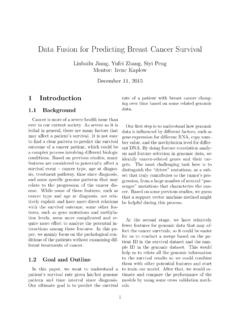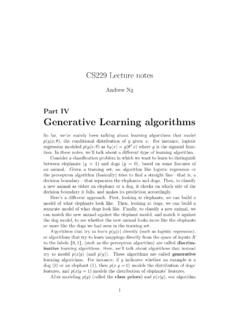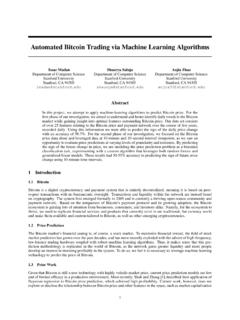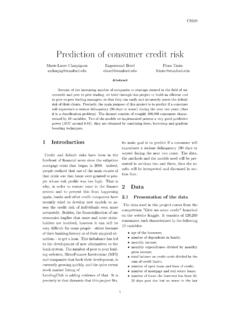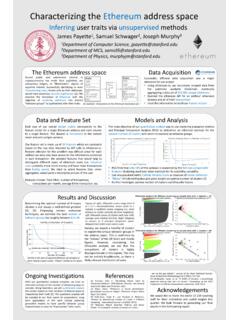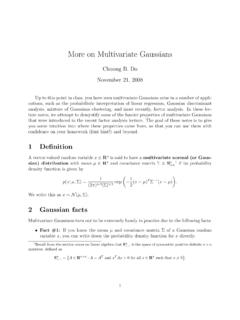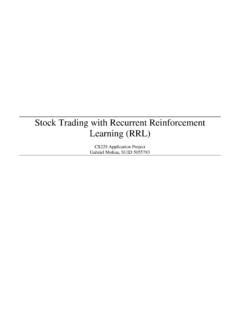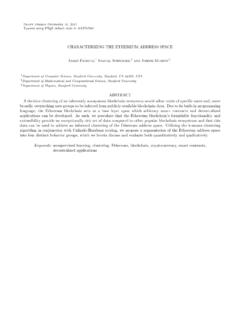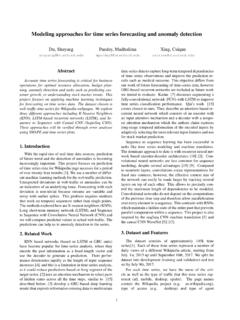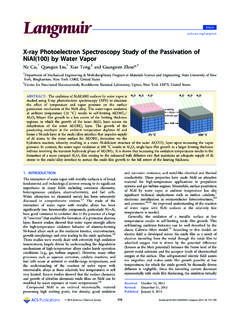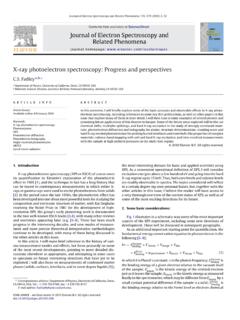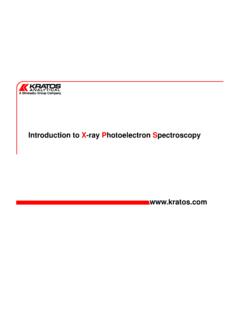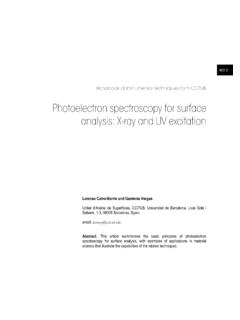Transcription of X-Ray Photoelectron Spectroscopy Enhanced by …
1 X-Ray Photoelectron Spectroscopy Enhanced by Machine Learning Alexander Gabourie Connor McClellan Sanchit Deshmukh 1. Introduction X-Ray Photoelectron Spectroscopy (XPS) is a technique for identifying individual elements in a mixture/compound. Samples are irradiated by X-rays and the kinetic energy of ejected electrons is measured. Ejected electrons are captured by a spectrometer and measured intensities are plotted versus kinetic energy (Fig. 1). Each element appears as a series of peaks distributed as Gaussians/Lorentzians.
2 From these peaks, material properties can be estimated. Current software for XPS systems attempts, but often fails, to correctly classify the sample. We would like to enhance this classification us-ing machine learning (ML) algorithms. Fig. 1: (Left) A drawing of the XPS characterization tech-nique. (Right) An example XPS measurement. Note that Ba has multiple peaks, each for different atomic orbitals [1]. The ultimate goal of this work is to create an algorithm that could correctly classify any compound given an XPS spectrum (Fig.)
3 1). This algorithm can be separated into two different tasks: First, Gaussians/Lorentzians are fit to the spectrum so to extract physically significant peaks. Second, a multi-class classification algorithm uses those peaks to identify the compound. This report addresses the second of the two tasks as it is better suited for a machine learning pro-ject. For this task, binding energies from elements/com-pound s XPS spectrums are used as input to multiple differ-ent learning algorithms. These algorithms will then output a predicted element/compound to classify the input signal.
4 The softmax regression, Support Vector Machine (SVM), and Na ve Bayes multi-class models will be trained to make ac-curate predictions. Initially, we develop algorithms to clas-sify pure elements and follow that work with full compound classification. 2. Related Work For better understanding of our problem and possible so-lutions, we looked for similar work on analyzing materials from spectral analysis data using ML techniques. We found that researchers tend to use SVM and Artificial Neural Net-work (ANN) algorithms for analyzing spectral data since both are robust classification techniques [2],[3].
5 However, a ANN would require a larger training set size than we could gather, leading us to using SVMs for our XPS classification. We further looked at Na ve Bayes and softmax regression because of both techniques do not inherently require large training set sizes. Na ve Bayes has been previously used for classification of Near-Infrared Spectroscopy , which is a sim-ilar technique to XPS, suggesting the algorithm could be used for XPS data classification [4]. We also found that lasso lo-gistic regression has been used for binary classification of spectral data [5].
6 However, since our problem requires mul-ticlassification, we chose to use softmax regression as a mul-tinomial generalization of logistic regression. 3. Data Collection and Refinement The National Institute of Standards and Technol-ogy (NIST) has compiled an extensive XPS database consist-ing of all reported XPS measurements that have been tabu-lated in academic journals, books, and webpages [6]. This database is public, but only available in an online entry-searchable format not suitable for data processing. Our initial efforts focused on aggregating all XPS information from the database with a custom web-scraper.
7 Each of the 33,369 entries in the XPS database consists of a 31-row table, where each row presents itself as a potential feature. Since the intention of this project is to help XPS us-ers identify elements/compounds from an XPS spectrum, and only binding energies, peak intensities, and Gaussian/Lo-rentzian widths of each peak can be extracted, only those three quantities from the database may be used in our learn-ing algorithms. Unfortunately, peak intensities and widths are seldom provided ruling those quantities out as features.
8 This leaves binding energy as the only quantity we can use in our learning algorithms. As seen in Fig. 1, an XPS spectrum is composed of mul-tiple peaks; however, each database entry contains only one peak. An element/compound s complete spectrum can still be constructed by combining multiple different entries from the database, although this reduces the effective dataset size. The list of peaks for each element/compound then acts as a feature vector for learning algorithms. Ultimately, we have a relatively size-restricted dataset, but an alternative is not available.
9 4. Methods Algorithms The following three learning algorithms were used to classify elements/compounds. Different assumptions on the input data are used but the underlying algorithms remain con-stant. Softmax Regression Since we are trying to solve a multinomial classification problem, a natural algorithm to choose would be the softmax regression. The scikit-learn [7] logistic regression model im-plements a softmax regression with the multinomial option enabled. Softmax regression is a generalized multinomial version of logistic regression that can classify an arbitrary number of classes.
10 We train the softmax regression algo-rithm by finding the parameters that minimize the cost function: Where ( ) is the classification vector for the number of elements, ( ) is the training parameter vector that constitutes the peak positions of each element/compound, is the learned parameter, and C is the penalty on the loss. The scikit-learn softmax implementation automatically includes L2 regularization in the cost function with the min , 12 term. In our project, we used the solvers Stochastic Average Gradient (SAG) and Newton Conjugate Gradient (Newton-CG) for training.
